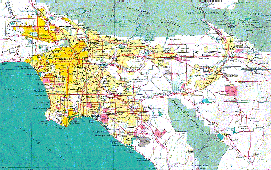1998 Economic and Demographic Information
 The City of Los Angeles is the
second most populous City in the United States with an estimated 1998 population in excess
of 3.7 million. Los Angeles is the principal city of a metropolitan region
stretching from the city of San Buenaventura to the north, the City of San Clemente to the
south, and the City of San Bernardino to the east. Los Angeles is full of smaller
communities each having its own unique characteristics. Visit the Westside Communities & their Demographics, or
download an Acrobat file with complete statistics & demographics on LA County as a
whole.
The City of Los Angeles is the
second most populous City in the United States with an estimated 1998 population in excess
of 3.7 million. Los Angeles is the principal city of a metropolitan region
stretching from the city of San Buenaventura to the north, the City of San Clemente to the
south, and the City of San Bernardino to the east. Los Angeles is full of smaller
communities each having its own unique characteristics. Visit the Westside Communities & their Demographics, or
download an Acrobat file with complete statistics & demographics on LA County as a
whole.
Founded in 1781, Los Angeles was for its first century a provincial outpost under a succession of Spanish, Mexican, and American rule. It experienced a population boom following its linkage by rail with San Francisco in 1876. Los Angeles was selected as the Southern California rail terminus because its natural harbor, unlike San Diego's, seemed to offer little challenge to San Francisco, home of the railroad barons. But what the region lacked in commerce and industry, it made up in temperate climate and unspoiled real estate, and soon tens and then hundreds of thousands of people living in the northeastern and midwestern United States migrated to new homes in the region. Its population climbed to 50,000 in 1890, and then swelled to 1.5 million by 1940. Agricultural and oil production, followed by the creation of a deep water port, the opening of the Panama Canal, and the completion of the City-financed Owens Valley Aqueduct to provide additional water, all contributed to an expanding economic base. During this same period, the motor car became the principal mode of American transportation, and Los Angeles developed as the first major city of the automotive age. Following World War II, Los Angeles became the focus of a new wave of migration, with its population reaching 2.4 million by 1960.
Both the City and its surrounding metropolitan region have continued to experience growth in population and in economic diversity. Services, wholesale and retail trade, manufacturing, government, financial service industries, transportation, utilities, and construction contribute significantly to local employment. The City's 470 square miles contain 11.5% of the area and 38.8% of the population of the County of Los Angeles (the "County). The County is the top ranked county in manufacturing in the United States, producing more than 10% of the nation's production of such diverse items as aircraft, aircraft equipment, aluminum, dental equipment, games and toys, gas transmissions and distribution equipment, guided missiles, space vehicles and propulsion units, and women's apparel. Fueled by trade with the Pacific Rim countries, the Port of Los Angeles/Long Beach ranks first in the nation in volume. As home to the film, television and recording industries, as well as important cultural facilities, Los Angeles serves as a principal global cultural center. With Los Angeles International Airport serving as the new "Ellis Island" for foreign immigration to this country, the metropolitan region has achieved a new ethnic and cultural diversity.